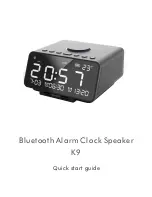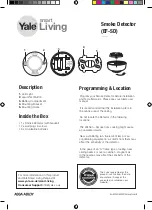
Installation Instructions
D285 and D285TH
Photoelectric Smoke Detectors
1.0 General Information
The D285 and D285TH are U.L. Listed, open-area photoelectric smoke detectors de-
signed for use with commercial fire protective signaling systems and household fire
warning systems (see NFPA 72, “The National Fire Alarm Code”). The detectors are
available in two and four wire models with an optional 135
°
F (57
°
C) fixed-temperature
heat sensor.
For commercial and industrial installations, 30 ft. (9.2 m) spacing between detectors is
recommended (in accordance with NFPA 72).
When properly installed using the D280/D290 Series bases, tamper protection is pro-
vided by IN/OUT wiring of the positive power line. This causes the control to initiate a
trouble signal when a detector is removed from its base. Supervision of 2-wire systems is
provided by the master control, and 4-wire system supervision is provided by an End-of-
Line Power Supervision device such as a D275 or a D293E Power Supervision Base and
an EOL resistor as specified by the control manufacturer.
2.0 Specifications
•
Product Description:
D285
Detector only (requires base)
D285TH
Detector w/integral 135
°
F heat sensor (requires base)
D287
Base only, 2-wire
D288
Base only: 2-wire, wide diameter
D292
Base only, 4-wire
D293A
Base only, 4-wire, Form “C” Aux. relay
D293E
Base only for power supervision, 4-wire, EOL relay, Normally Open Aux.
relay
D293S
Base only, 4-wire, with Sounder
D275
EOL supervision module for 4-wire systems
The U.L. Compatibility Identifier for the D285 and D285TH detectors is the letter “A.”
To determine the U.L. Compatibility Identifier for use with the D287 base, see
Technogram P/N 31866.
•
Operating Temperature:
+32
°
to 100
°
F (0
°
to 38
°
C). 0 to 95% relative humidity
(non-condensing).
•
Detector Power Requirements:
Standby Voltage:
2-wire - 8.5 to 33.0 VDC
4-wire - 10.0 to 30.0 VDC
Maximum RMS Ripple:
25 percent of DC input.
Start-up Current:
120 micro-amps maximum
Standby Current:
80 micro-amps @ 12 VDC
90 micro-amps @ 24 VDC
100 micro-amps @ 33 VDC
Note: The D293E = 24 mA @12 & 24 VDC
•
Alarm Current:
2-wire
Dependent on control panel. Panel must limit the alarm current to 100 mA
maximum.
4-wire
D292:
48 mA @ 12 VDC
51 mA @ 24 VDC
(70 mA max. @ 30 VDC)
D293A:
56 mA @ 12 & 24 VDC
(75 mA max. @ 30 VDC)
D293E:
80 mA @ 12 and 24 VDC
(100 mA max. @ 30 VDC)
D293S:
Base 48 mA @ 12 VDC
Sounder 15 mA @ 12 VDC, 25 mA @ 24 VDC
Power-up Time: 22 seconds maximum.
Compatible Control Panels:
2-wire:
See Technogram P/N 31866.
Notice: Radionics, Inc. makes no claim written, oral, or implied that the D285
Series smoke detectors will work with any 2-wire control panels except those
specified in the Base Compatibility chart in the Technogram 31866.
4-wire:
Compatible with all U.L. Listed 4-wire control panels. Refer to the
manufacturer's Installation Instructions for proper End-of-Line resistor selec-
tion.
3.0 Mounting
Before mounting, remove the dust cover from the detector. The dust cover may be re-
placed during construction periods, but must be removed once the alarm system is en-
abled.
Note:
The Tamper screw is located in the recess on the top of the dust cover.
Mount the base in accordance with its instructions.
Mount the detector to the base by turning it clockwise until it clicks into place. When it is
secure, the alignment line will be lined-up with the tamper screw hole (see Figure A).
Note:
The detectors are “keyed” and should not be forced onto the bases.
Base contacts
(3 sets)
Alignment
arrow
Start detector
contacts here and
rotate clockwise
Figure A - Mounting to the base
4.0 Testing the Installation
Check the wiring from the control panel to the last head on each run for proper polarity
and continuity.
-
Make sure each run terminates with an End-of-Line resistor as specified by the con-
trol panel manufacturer.
-
Make sure 4-wire runs terminate with EOL Modules or D293E bases.
Apply power to the system. Check for alarms and troubles.
-
Note which detectors are in alarm (if any) and then shut the system down. Remove
these detectors from their bases and recheck the bases for proper wiring. If the prob-
lems persist, replace the affected detectors or swap them with known good units. This
will determine if the problem is caused by the detector or the base.
-
In the event of a system alarm with no detector alarms present, remove all detectors
and check the wiring at each base. Pay close attention to the wiring of each EOL
Resistor and EOL Module.
When the system is free of alarms, check each detector to ensure that the red LED indi-
cator is flashing approximately every three seconds. This verifies that the detector is
receiving power and operating properly.
Test each detector to ensure it will cause a control panel alarm. This is the only way to
ensure proper operation.
To alarm the detectors, do one of the following:
-
Place a magnet horizontally against the detector’s side (centered over the “T” marked
on the head) to activate an internal reed switch, or
-
Use a U.L. listed Aerosol smoke detector tester such as the Home Safeguard Indus-
tries’ 25S to simulate an alarm. Follow the instructions with the Aerosol smoke detec-
tor tester.
Note:
When a detector alarms, the red LED indicator will activate and latch into the
ON position. Clear the alarm before proceeding to the next detector.
Finally, check the overall loading of the alarm loop by measuring the voltage across each
End-of-Line Resistor. This voltage should equal or exceed the minimum specified by the
control panel manufacturer.
5.0 Maintenance
Note:
It is important to notify all concerned parties prior to any maintenance or testing
of the fire alarm system, and then again after completion of these activities.
At least once a year, the detector and base should be cleaned. Use a vacuum or clean/
dry compressed air. Particular attention should be paid to the screens. In dusty areas or
areas of heavy insect concentration, cleaning may be required more often.
To clean the detectors, perform the following:
-
Remove the detector from the base. Clean the base with a clean cloth and common
window cleaner.
D285 Installation Instructions
Page 1
© 1996 Radionics
P/N 31342B
™




















